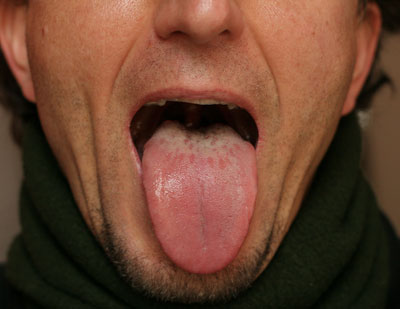Those unfamiliar with the principles of traditional Chinese medicine may be surprised when an acupuncturist asks to see their tongue. However, this tongue inspection plays an important role in diagnosis, developing a treatment plan, and gauging progress. The tongue can be a window into your health and is connected to the meridians and organs. What is the practitioner looking for?

1. Color: A healthy tongue tends to be light red or pink with a thin coating. However, the color of the tongue varies by person. In general, a dark red tongue is a sign that there is excess heat in the body. The darker red, the more heat present.
A purple or bluish tongue shows the practitioner that there is stagnation and the exact hue and coating can reveal where the imbalance is occurring. A pale tongue means there is a deficiency, such as deficient qi, blood, or yang. It can cause cold in the body.
In addition to the color of the tongue body, there can also be variations on different parts of the tongue. For example, the tip of the tongue is correlated with the Heart and a dark red tip is a sign that there is excessive heat in the Heart. The color of the back of the tongue clues practitioners into the health of the Kidney.
2. Coating: Ask any dentist and they’ll tell you that brushing or scraping your tongue is an excellent way to get rid of bad breath and maintain oral health. Certain fields of alternative medicine recommend it for detoxification purposes. The tongue tends to harbor microbes and food particles. Yet, a licensed acupuncturist needs to see this coating, which is why you shouldn’t scrape your tongue for approximately 24 hours prior to an appointment.
The thickness of the coating is a clue. A thin coat can indicate that a condition is mild. A thick coating is a sign that the condition is more serious, while no coating or a peeling coating means heat or that Stomach qi and yin, Kidney yin, or other areas are deficient or damaged.
The color of the coating plays a role in diagnosis. For example, a yellow coating is a sign of heat, while a gray tongue coating reveals internal heat or damp-cold patterns. The quality of coating is also important. A dry tongue means deficient fluids and a wet tongue is tied to dampness and poor fluid metabolism.
3. Shape or Size: The shape and size of the tongue are often indicative of fluid balance, the state of blood, excesses, and deficiencies. Similar to color and coating, the shape and size of the tongue varies by patient. Tongues can be stiff, thin, swollen, long, and anything in between. A flaccid pale tongue is typically a sign of qi and blood deficiencies, while a red swollen tongue, particularly if painful, is correlated with Heart and Spleen heat. The movement of the tongue is also considered.
This primer doesn’t encompass the entire multi-faceted art of tongue diagnosis. It takes a highly trained practitioner to understand all of the nuances. Factors, such as age, the season, food and beverages, and even the time of day influence the tongue’s appearance. A licensed acupuncturist with extensive training in traditional Chinese medicine will take all of this into account when performing a tongue diagnosis.